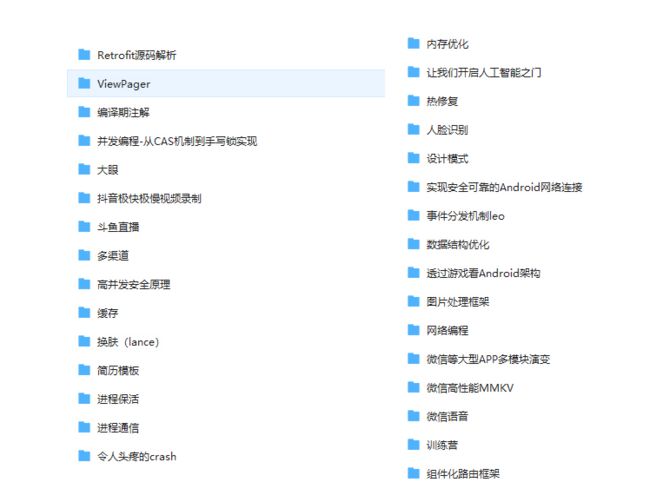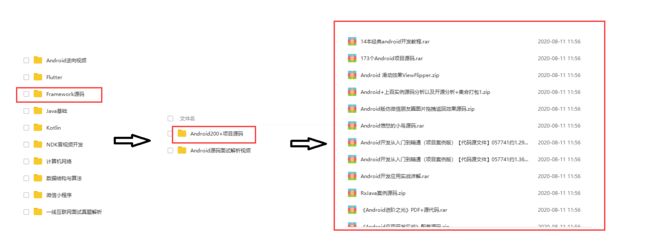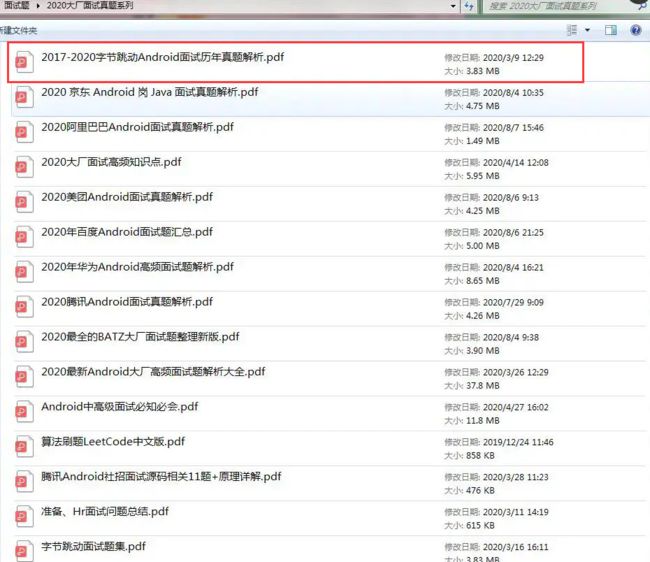Android源码解析——Handler,凭借这份《数据结构与算法》核心文档
sendMessageAtTime() 方法中在处理 Message 时,最终调用的是 enqueueMessage() 方法
当中,需要注意 msg.target = this 这句代码,target 对象指向了发送消息的主体,即 Handler 对象本身,即由 Handler 对象发给 MessageQueue 的消息最后还是要交由 Handler 对象本身来处理
public boolean sendMessageAtTime(Message msg, long uptimeMillis) {
MessageQueue queue = mQueue;
if (queue == null) {
RuntimeException e = new RuntimeException(
this + " sendMessageAtTime() called with no mQueue");
Log.w(“Looper”, e.getMessage(), e);
return false;
}
return enqueueMessage(queue, msg, uptimeMillis);
}
private boolean enqueueMessage(MessageQueue queue, Message msg, long uptimeMillis) {
//target 对象指向的也是发送消息的主体,即 Handler 对象
//即由 Handler 对象发给 MessageQueue 的消息最后还是要交由 Handler 对象本身来处理
msg.target = this;
if (mAsynchronous) {
msg.setAsynchronous(true);
}
return queue.enqueueMessage(msg, uptimeMillis);
}
因为存在多个线程同时往同一个 Loop 线程的 MessageQueue 中插入消息的可能,所以 enqueueMessage() 内部需要进行同步。可以看出 MessageQueue 内部是以链表的结构来存储 Message 的(Message.next),根据 Message 的延时时间的长短来将决定其在消息队列中的位置
mMessages 代表的是消息队列中的第一条消息,如果 mMessages 为空,说明消息队列是空的,或者 mMessages 的触发时间要比新消息晚,则将新消息插入消息队列的头部;如果 mMessages 不为空,则寻找消息列队中第一条触发时间比新消息晚的非空消息,并将新消息插到该消息前面
到此,一个按照处理时间进行排序的消息队列就完成了,后边要做的就是从消息队列中依次取出消息进行处理了
boolean enqueueMessage(Message msg, long when) {
//Message 必须有处理者
if (msg.target == null) {
throw new IllegalArgumentException(“Message must have a target.”);
}
if (msg.isInUse()) {
throw new IllegalStateException(msg + " This message is already in use.");
}
synchronized (this) {
if (mQuitting) {
IllegalStateException e = new IllegalStateException(
msg.target + " sending message to a Handler on a dead thread");
Log.w(TAG, e.getMessage(), e);
msg.recycle();
return false;
}
msg.markInUse();
msg.when = when;
Message p = mMessages;
boolean needWake;
//如果消息队列是空的或者队列中第一条的消息的触发时间要比新消息长,则将新消息作为链表头部
if (p == null || when == 0 || when < p.when) {
// New head, wake up the event queue if blocked.
msg.next = p;
mMessages = msg;
needWake = mBlocked;
} else {
// Inserted within the middle of the queue. Usually we don’t have to wake
// up the event queue unless there is a barrier at the head of the queue
// and the message is the earliest asynchronous message in the queue.
needWake = mBlocked && p.target == null && msg.isAsynchronous();
Message prev;
//寻找消息列队中第一条触发时间比新消息晚的消息,并将新消息插到该消息前面
for (; {
prev = p;
p = p.next;
if (p == null || when < p.when) {
break;
}
if (needWake && p.isAsynchronous()) {
needWake = false;
}
}
msg.next = p; // invariant: p == prev.next
prev.next = msg;
}
// We can assume mPtr != 0 because mQuitting is false.
if (needWake) {
nativeWake(mPtr);
}
}
return true;
}
下面再看下 MessageQueue 是如何读取 Message 并回调给 Handler 的
在 MessageQueue 中消息的读取其实是通过内部的 next() 方法进行的,next() 方法是一个无限循环的方法,如果消息队列中没有消息,则该方法会一直阻塞,当有新消息来的时候 next() 方法会返回这条消息并将其从单链表中删除
Message next() {
// Return here if the message loop has already quit and been disposed.
// This can happen if the application tries to restart a looper after quit
// which is not supported.
final long ptr = mPtr;
if (ptr == 0) {
return null;
}
int pendingIdleHandlerCount = -1; // -1 only during first iteration
int nextPollTimeoutMillis = 0;
for (; {
if (nextPollTimeoutMillis != 0) {
Binder.flushPendingCommands();
}
nativePollOnce(ptr, nextPollTimeoutMillis);
synchronized (this) {
// Try to retrieve the next message. Return if found.
final long now = SystemClock.uptimeMillis();
Message prevMsg = null;
Message msg = mMessages;
if (msg != null && msg.target == null) {
// Stalled by a barrier. Find the next asynchronous message in the queue.
do {
prevMsg = msg;
msg = msg.next;
} while (msg != null && !msg.isAsynchronous());
}
if (msg != null) {
if (now < msg.when) {
// Next message is not ready. Set a timeout to wake up when it is ready.
nextPollTimeoutMillis = (int) Math.min(msg.when - now, Integer.MAX_VALUE);
} else {
// Got a message.
mBlocked = false;
if (prevMsg != null) {
prevMsg.next = msg.next;
} else {
mMessages = msg.next;
}
msg.next = null;
if (DEBUG) Log.v(TAG, "Returning message: " + msg);
msg.markInUse();
return msg;
}
} else {
// No more messages.
nextPollTimeoutMillis = -1;
}
// Process the quit message now that all pending messages have been handled.
if (mQuitting) {
dispose();
return null;
}
// If first time idle, then get the number of idlers to run.
// Idle handles only run if the queue is empty or if the first message
// in the queue (possibly a barrier) is due to be handled in the future.
if (pendingIdleHandlerCount < 0
&& (mMessages == null || now < mMessages.when)) {
pendingIdleHandlerCount = mIdleHandlers.size();
}
if (pendingIdleHandlerCount <= 0) {
// No idle handlers to run. Loop and wait some more.
mBlocked = true;
continue;
}
if (mPendingIdleHandlers == null) {
mPendingIdleHandlers = new IdleHandler[Math.max(pendingIdleHandlerCount, 4)];
}
mPendingIdleHandlers = mIdleHandlers.toArray(mPendingIdleHandlers);
}
// Run the idle handlers.
// We only ever reach this code block during the first iteration.
for (int i = 0; i < pendingIdleHandlerCount; i++) {
final IdleHandler idler = mPendingIdleHandlers[i];
mPendingIdleHandlers[i] = null; // release the reference to the handler
boolean keep = false;
try {
keep = idler.queueIdle();
} catch (Throwable t) {
Log.wtf(TAG, “IdleHandler threw exception”, t);
}
if (!keep) {
synchronized (this) {
mIdleHandlers.remove(idler);
}
}
}
// Reset the idle handler count to 0 so we do not run them again.
pendingIdleHandlerCount = 0;
// While calling an idle handler, a new message could have been delivered
// so go back and look again for a pending message without waiting.
nextPollTimeoutMillis = 0;
}
}
next() 方法又是通过 Looper 类的 loop() 方法来循环调用的,而 loop() 方法也是一个无限循环,唯一跳出循环的条件就是 queue.next() 方法返回为null ,细心的读者可能已经发现了,loop() 就是在 ActivityThread 的 main()函数中调用的
因为 next() 方法是一个阻塞操作,所以当没有消息也会导致 loop() 方法一只阻塞着,而当 MessageQueue 一中有了新的消息,Looper 就会及时地处理这条消息并调用 Message.target.dispatchMessage(Message) 方法将消息传回给 Handler 进行处理
/**
-
Run the message queue in this thread. Be sure to call
-
{@link #quit()} to end the loop.
*/
public static void loop() {
final Looper me = myLooper();
if (me == null) {
throw new RuntimeException(“No Looper; Looper.prepare() wasn’t called on this thread.”);
}
final MessageQueue queue = me.mQueue;
// Make sure the identity of this thread is that of the local process,
// and keep track of what that identity token actually is.
Binder.clearCallingIdentity();
final long ident = Binder.clearCallingIdentity();
for (; {
Message msg = queue.next(); // might block
if (msg == null) {
// No message indicates that the message queue is quitting.
return;
}
// This must be in a local variable, in case a UI event sets the logger
final Printer logging = me.mLogging;
if (logging != null) {
logging.println(">>>>> Dispatching to " + msg.target + " " +
msg.callback + ": " + msg.what);
}
final long slowDispatchThresholdMs = me.mSlowDispatchThresholdMs;
final long traceTag = me.mTraceTag;
if (traceTag != 0 && Trace.isTagEnabled(traceTag)) {
Trace.traceBegin(traceTag, msg.target.getTraceName(msg));
}
final long start = (slowDispatchThresholdMs == 0) ? 0 : SystemClock.uptimeMillis();
final long end;
try {
msg.target.dispatchMessage(msg);
end = (slowDispatchThresholdMs == 0) ? 0 : SystemClock.uptimeMillis();
} finally {
if (traceTag != 0) {
Trace.traceEnd(traceTag);
}
}
if (slowDispatchThresholdMs > 0) {
final long time = end - start;
if (time > slowDispatchThresholdMs) {
Slog.w(TAG, "Dispatch took " + time + "ms on "
- Thread.currentThread().getName() + “, h=” +
msg.target + " cb=" + msg.callback + " msg=" + msg.what);
}
}
if (logging != null) {
logging.println("<<<<< Finished to " + msg.target + " " + msg.callback);
}
// Make sure that during the course of dispatching the
// identity of the thread wasn’t corrupted.
final long newIdent = Binder.clearCallingIdentity();
if (ident != newIdent) {
Log.wtf(TAG, “Thread identity changed from 0x”
-
Long.toHexString(ident) + " to 0x"
-
Long.toHexString(newIdent) + " while dispatching to "
-
msg.target.getClass().getName() + " "
-
msg.callback + " what=" + msg.what);
}
msg.recycleUnchecked();
}
}
看下 Handler 对象处理消息的方法
/**
- Handle system messages here.
*/
public void dispatchMessage(Message msg) {
if (msg.callback != null) {
handleCallback(msg);
} else {
if (mCallback != null) {
if (mCallback.handleMessage(msg)) {
return;
}
}
handleMessage(msg);
}
}
如果 msg.callback 不为 null ,则调用 callback 对象的 run() 方法,该 callback 实际上就是一个 Runnable 对象,对应的是 Handler 对象的 post() 方法
private static void handleCallback(Message message) {
message.callback.run();
}
public final boolean post(Runnable r){
return sendMessageDelayed(getPostMessage®, 0);
}
private static Message getPostMessage(Runnable r) {
Message m = Message.obtain();
m.callback = r;
return m;
}
如果 mCallback 不为 null ,则通过该回调接口来处理消息,如果在初始化 Handler 对象时没有通过构造函数传入 Callback 回调接口,则交由 handleMessage(Message) 方法来处理消息,我们一般也是通过重写 Handler 的 handleMessage(Message) 方法来处理消息
最后来总结下以上的内容
-
在创建 Handler 实例时要么为构造函数提供一个 Looper 实例,要么默认使用当前线程关联的 Looper 对象,如果当前线程没有关联的 Looper 对象,则会导致抛出异常
-
Looper 与 Thread ,Looper 与 MessageQueue 都是一一对应的关系,在关联后无法更改,但 Handler 与 Looper 可以是多对一的关系
-
Handler 能用于更新 UI 有个前提条件:Handler 与主线程关联在了一起。在主线程中初始化的 Handler 会默认与主线程绑定在一起,所以此后在处理 Message 时,
handleMessage(Message msg)方法的所在线程就是主线程,因此 Handler 能用于更新 UI -
可以创建关联到另一个线程 Looper 的 Handler,只要本线程能够拿到另外一个线程的 Looper 实例
new Thread(“Thread_1”) {
@Override
public void run() {
Looper.prepare();
final Looper looper = Looper.myLooper();
new Thread(“Thread_2”) {
@Override
public void run() {
Handler handler = new Handler(looper);
handler.post(new Runnable() {
@Override
public void run() {
//输出结果是:Thread_1
Log.e(TAG, Thread.currentThread().getName());
}
});
}
}.start();
Looper.loop();
}
}.start();
尾声
如果你想成为一个优秀的 Android 开发人员,请集中精力,对基础和重要的事情做深度研究。
对于很多初中级Android工程师而言,想要提升技能,往往是自己摸索成长,不成体系的学习效果低效漫长且无助。 整理的这些架构技术希望对Android开发的朋友们有所参考以及少走弯路,本文的重点是你有没有收获与成长,其余的都不重要,希望读者们能谨记这一点。
这里,笔者分享一份从架构哲学的层面来剖析的视频及资料分享给大家梳理了多年的架构经验,筹备近6个月最新录制的,相信这份视频能给你带来不一样的启发、收获。
Android进阶学习资料库
一共十个专题,包括了Android进阶所有学习资料,Android进阶视频,Flutter,java基础,kotlin,NDK模块,计算机网络,数据结构与算法,微信小程序,面试题解析,framework源码!
大厂面试真题
PS:之前因为秋招收集的二十套一二线互联网公司Android面试真题 (含BAT、小米、华为、美团、滴滴)和我自己整理Android复习笔记(包含Android基础知识点、Android扩展知识点、Android源码解析、设计模式汇总、Gradle知识点、常见算法题汇总。)
《2019-2021字节跳动Android面试历年真题解析》
-
自行下载直达领取链接:【GitHub】
-
以上进阶BATJ大厂学习资料可以免费分享给大家,需要完整版的朋友,【点这里可以看到全部内容】。
]
大厂面试真题
PS:之前因为秋招收集的二十套一二线互联网公司Android面试真题 (含BAT、小米、华为、美团、滴滴)和我自己整理Android复习笔记(包含Android基础知识点、Android扩展知识点、Android源码解析、设计模式汇总、Gradle知识点、常见算法题汇总。)
[外链图片转存中…(img-BuEFQrv5-1644996426251)]
《2019-2021字节跳动Android面试历年真题解析》
[外链图片转存中…(img-D17lgeCE-1644996426252)]
-
自行下载直达领取链接:【GitHub】
-
以上进阶BATJ大厂学习资料可以免费分享给大家,需要完整版的朋友,【点这里可以看到全部内容】。



